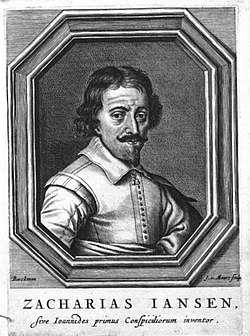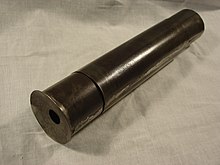Zacharias Janssen: Difference between revisions
m Reverted edits by 203.177.92.99 (talk) to last revision by Hmrox (HG) |
|||
| Line 36: | Line 36: | ||
Following the death of Janssen's first wife in 1624, he married Anna Couget from Antwerp, who was the widow of a Willem Jansen (probably a relative of Jansen). He moved to Amsterdam in November 1626. Janssen has been given a death date as late as 1638<ref name="David Whitehouse 2009, page 67"/> although his son Johannes declared his parents had died by the time of his marriage in April 1632.<ref name="Zuidervaart" /> |
Following the death of Janssen's first wife in 1624, he married Anna Couget from Antwerp, who was the widow of a Willem Jansen (probably a relative of Jansen). He moved to Amsterdam in November 1626. Janssen has been given a death date as late as 1638<ref name="David Whitehouse 2009, page 67"/> although his son Johannes declared his parents had died by the time of his marriage in April 1632.<ref name="Zuidervaart" /> |
||
my mom was here and he jojo up |
|||
==Inventions== |
==Inventions== |
||
Revision as of 00:06, 16 May 2013
Zacharias Janssen | |
|---|---|
 Zacharias Janssen | |
| Born | 1580-1588? |
| Died | given as before 1632 or 1638 |
| Citizenship | Dutch |
| Known for | Early innovations in microscopy and telescopy |
| Scientific career | |
| Fields | Optics: Microscopy, Telescopy |
| Academic advisors | Academic : Academy of the name Zacharias |
Zacharias Janssen (also Zacharias Jansen or Sacharias Jansen) (b.1580-88, d.pre-1632 to 1638) was a Dutch spectacle-maker from Middelburg associated with the invention of the first optical telescope. Janssen is sometimes also credited for inventing the first truly compound microscope. However, the origin of the microscope, just like the origin of the telescope, is a matter of debate.
Biography
Janssen was born in The Hague with date of birth commonly given as 1580[1] although some sources place it as late a 1588.[2] His parents were Hans Martens[3] (who may have had the occupation of a peddler)[4] and Maeyken Meertens, both probably from Antwerp, Belgium. He grew up with his sister Sara in Middelburg, at the time the second most important city of the Netherlands. He was known as a "street seller" who was constantly in trouble with the local authorities, and later became a spectacle-maker.[4]
He himself stated he was born in The Hague on the marriage file of his first marriage, with Catharina de Haene, on October 23, 1610. When this file was refound by Cornelis de Waard in 1906, De Waard found the following excerpt: Sacharias Jansen, j.g. uut Den Haag, translated into modern English: Zacharias Jansen, bachelor from The Hague[3] Before, it was often thought that Janssen was a native of Middleburg. In 1612, Zacharias and Catharina had a son they named Johannes Zachariassen.
Following the death of Janssen's first wife in 1624, he married Anna Couget from Antwerp, who was the widow of a Willem Jansen (probably a relative of Jansen). He moved to Amsterdam in November 1626. Janssen has been given a death date as late as 1638[1] although his son Johannes declared his parents had died by the time of his marriage in April 1632.[3]
Inventions
By choosing the profession of spectacle-maker, Janssen entered a very competitive and secretive trade. These factors may have played a role in Janssen's claims of invention of the telescope and the microscope since he and Middelburg spectacle maker Hans Lippershey were direct competitors who practically lived next door to each other. Janssen's attribution to these discoveries is debatable since there is no concrete evidence as to the actual inventor, and there are a whole series of confusing and conflicting claims from the testimony of his son and fellow countrymen, in different investigations that took place 20 to 65 years after the claimed invention.[5]
Microscope
Janssen has been associated with invention of the a single-lens (simple) optical microscope and the compound (2 or more lens) 9x magnification optical microscope, sometimes claimed to have been devised with the help of his father (or sometimes said to have been built entirely by his father)[6] with a date of invention commonly given as 1590[7][8] (or sometimes 1595), while trying to find a way to make magnification even greater to help people with seriously poor eyesight.
The confusion surrounding the claim to invention arises from the (sometimes conflicting) testimony of Janssen's son, Johannes Zachariassen. Johannes seems to have given inaccurate testimony regarding his father's date of birth, and claimed that his father invented a telescope in 1590, and that telescopes and microscopes they sold were later copied by other inventors.[5] A claimed Janssen date of birth of 1580 would make him 10 years old at the given date for invention (although an outside invention date of 1595 would make him 15), and a birth date of 1588 would make him 2 years old at the claimed time of the invention.[clarification needed]
Telescope
Janssen is one of three people who have been associated with the invention of the telescope in the Netherlands in 1608.[9] That year Hans Lippershey filed the first known patent for the device on October 2 with the States-General of the Netherlands, followed a few weeks later by a second patent application by Jacob Metius of Alkmaar. Both were turned down because there were counter claims for the invention.[10]
There are varying accounts and debate as to whether Janssen was actually the inventor of the telescope. German astronomer Simon Marius wrote an account of his patron Johan Philip Fuchs von Bimbach meeting an unnamed Dutchman at the 1608 Autumn Frankfurt Fair (which ran the month of September) who tried to sell him a device that sounded like a telescope.[11] Given his history as a street seller, there is speculation this unnamed Dutchman could have been Zacharias Janssen, which would mean Janssen had a telescope at least a month before Lippershey's October 2, 1608 patent date. William de Boreel, who visited Middelburg to research the invention in 1655, interviewed Janssen's son Johannes. Boreel concluded that Janssen's telescope was finished about 1610. His research was referenced by Pierre Borel in De vero telescopii inventore.[12] There are other claims that Janssen constructed the first telescope in 1604, or even earlier.[3] Janssen's son Johannes testified under oath that Hans Lippershey had stolen his father's invention of the telescope, and that his father had invented the device in 1590.[5]

The claim that Janssen invented the telescope was not well known outside the Netherlands. Lippershey's claim to the invention was the most prominent, since he had the first recorded patent and strongly promoted it.[14] Whilst that news was spread across the world in just a few months (eventually Galileo Galilei heard about it), several investigations on the subject in the 17th, 18th, 19th and 20th century, stating Janssen might have invented the device, were only published and read in the Netherlands. To make it even worse, just one of the investigations was published in English and just that one stated Lippershey did invent the telescope, making Janssen even more infamous in countries outside the Netherlands.
Albert Van Helden, Sven Dupré, Rob Van Gent, and Huib Zuidervaart in their book "Origins of the Telescope" came to the conclusion that Janssen may not have become an optician until 1616 and that the claims surrounding him as the inventor of the telescope and the microscope were the fabrications of his own son who claimed it as a matter of fame and for possible financial gain.[5]
Illegal activities
In the years 1613–1619, Janssen was tried several times for counterfeiting coins. Janssen grew up right next to the Middleburg mint where his brother-in-law worked. These circumstances made it very easy for Janssen to mimic the process of manufacturing money. He fled to the neighbouring village of Arnemuiden to avoid the high penalties for counterfeiting coins.[3]
However, he continued counterfeiting coins in Arnemuiden. In 1619 he was apprehended for owning several devices he counterfeited coins with. Normally, one would have been sentenced to death for this crime. However, since the father of the Arnemuiden bailiff was found to be an accessory, it turned out better for Janssen. Thanks to this, the process was delayed to such an extent that Janssen was able to flee yet another time. Eventually, the case was dismissed. Janssen returned to Middleburg in 1621.[3]
Historical record
Janssen's life was documented by the many investigations on the subject before the Second World War. Many of the Middelburg archives were destroyed by a devastating bombardment on May 17, 1940, during the Nazi invasion of the Netherlands. If there had never been profound investigations, very little would be known of Janssen's life at all, since all files were lost in the fires following the bombardment.
References
- ^ a b David Whitehouse, Renaissance Genius: Galileo Galilei & His Legacy to Modern Science - 2009, page 67
- ^ Ari Ben-Menahem, Historical Encyclopedia of Natural and Mathematical Sciences - Volume 1 - 2009, page 5294
- ^ a b c d e f Source: a book by Huib J. Zuidervaart which is to be published in the spring of 2008. The Public Observatory Philippus Lansbergen in Middelburg has already been shown a first version of this book.
- ^ a b David Whitehouse, Renaissance Genius: Galileo Galilei & His Legacy to Modern Science, pages 67
- ^ a b c d Albert Van Helden, Sven Dupre, Rob Van Gent, The Origins of the Telescope - 2011, page 43
- ^ Brian Shmaefsky, Biotechnology 101 - 2006, page 171
- ^ Stewart, Gail B. The Kid Haven Science Library: Microscopes. Farmington Hills, MI: Kid Heaven Press, 2003. PRINT
- ^ Molecular Expressions Microscopy Primer: Museum of Microscopy – The Janssen Microscope
- ^ galileo.rice.edu Al Van Helden,The Galileo Project > Science > The Telescope
- ^ Osservatorio Astronomico di Bologna – TELESCOPES "The request however was turned down, also because other spectacle-makers had made similar claims at the same time."
- ^ David Whitehouse, Renaissance Genius: Galileo Galilei & His Legacy to Modern Science, pages 69–70
- ^ King, Henry C. The History of the Telescope. Courier Dover Publications. 1955/2003.
- ^ Albert Van Helden, Sven Dupré, Rob Van Gent, Huib Zuidervaart, The Origins of the Telescope, pages 32-36
- ^ he History of the Telescope By Henry C. King, page 30
